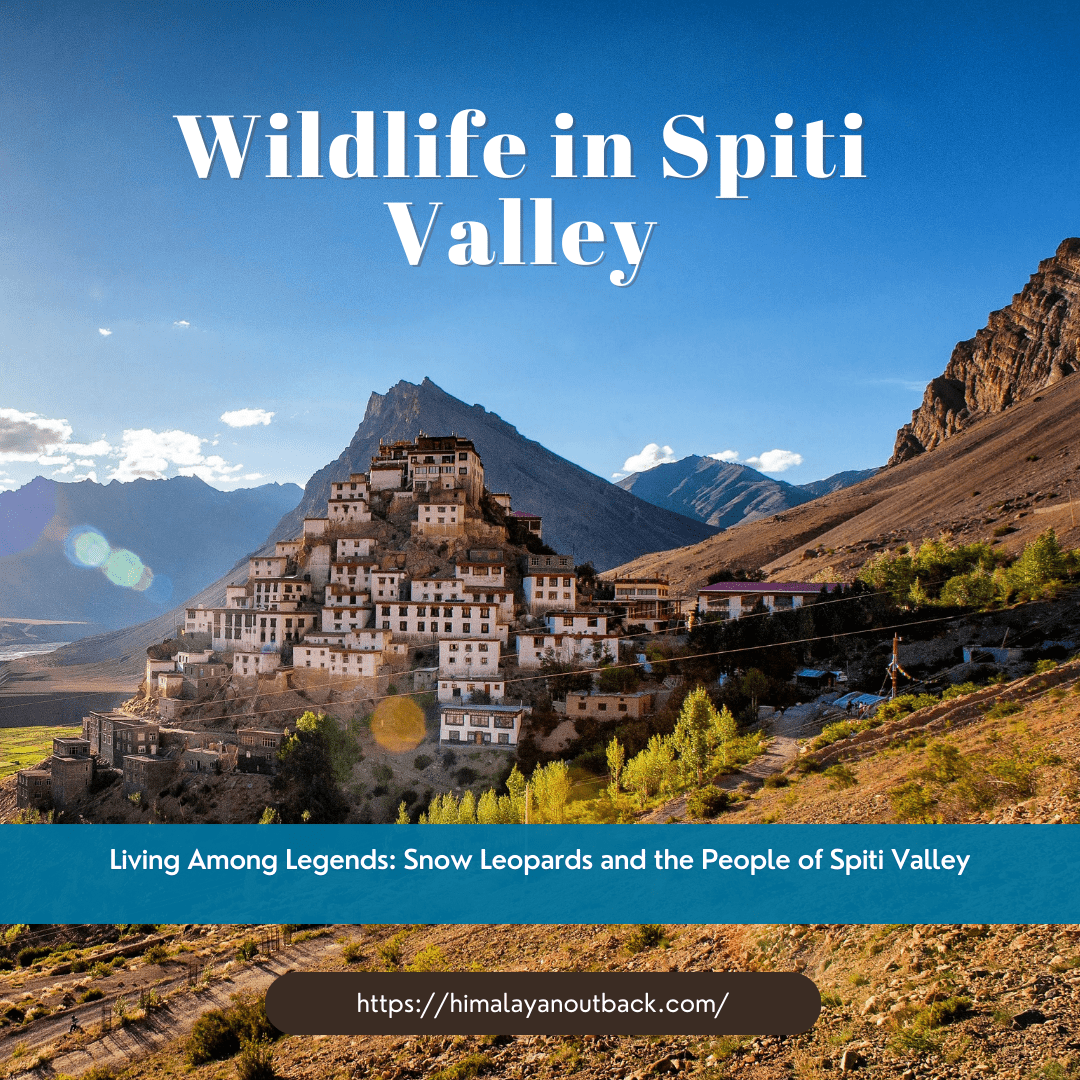High in the trans-Himalayan desert of Spiti Valley, where ancient monasteries perch on barren cliffs and prayer flags flutter against azure skies, an extraordinary relationship is unfolding between humans and one of the world’s most elusive predators. The snow leopard, known locally as the “grey ghost,” has found an unlikely sanctuary among the communities that call this remote corner of Himachal Pradesh home.
For centuries, these magnificent cats roamed the high-altitude wilderness in solitude, their presence more myth than reality. Today, something remarkable is happening. Wildlife in Spiti has become a beacon of hope for conservation, where ancient wisdom meets modern protection efforts, creating a model for coexistence that’s capturing the attention of wildlife enthusiasts worldwide.
The transformation of Spiti Valley from a place where snow leopards were feared or hunted to one where they’re protected and celebrated represents one of conservation’s most inspiring success stories. Local communities have become the guardians of these apex predators, proving that when humans and wildlife work together, both can thrive.
The Grey Ghost Emerges from the Shadows
Snow leopards have long been creatures of legend in the high Himalayas. Their smoke-colored coat, marked with dark rosettes, allows them to blend seamlessly into the rocky terrain between 3,000 and 4,500 meters above sea level. These solitary hunters once moved through Spiti’s landscape like phantoms, leaving only paw prints in fresh snow as evidence of their presence.
The global population of snow leopards remains critically low, with estimates ranging between 3,920 and 6,390 individuals worldwide. Classified as endangered on the IUCN Red List, these cats face mounting pressures from habitat loss, climate change, and human-wildlife conflict. Yet in Spiti Valley, their story is taking a different turn.
Recent years have brought an unprecedented increase in snow leopard sightings throughout the valley. What was once considered a once-in-a-lifetime encounter has become increasingly common, with spotting chances now reaching an impressive 50% during peak viewing seasons. This dramatic shift reflects not just better conservation efforts, but a fundamental change in how local communities view these apex predators.
The Kibber Wildlife Sanctuary, nestled in the heart of Spiti, has emerged as a critical stronghold for snow leopards. Wildlife officials estimate that approximately 30 adult cats call this protected area home, with numerous cubs spotted in recent years—a promising sign for the species’ future. The sanctuary’s success demonstrates how targeted conservation efforts, combined with community support, can create safe havens for endangered species.
When Ancient Wisdom Meets Modern Conservation
The transformation of human-snow leopard relationships in Spiti didn’t happen overnight. For generations, local communities viewed these predators as threats to their livestock—their primary source of livelihood in this harsh, high-altitude environment. Traditional pastoral communities relied heavily on yaks, sheep, and goats, making any predation a significant economic loss.
However, a shift in perspective began when conservation organizations started working directly with local communities, introducing compensation schemes for livestock losses and alternative livelihood opportunities. Villages like Kibber, Tashigang, and Pin began to see snow leopards not as threats, but as valuable assets that could attract eco-tourists and researchers to their remote valley.
Community-based conservation programs have trained local residents as wildlife guides and spotters. These former herders now use their intimate knowledge of the landscape to help visitors glimpse the elusive cats. Their traditional understanding of animal behavior, combined with modern conservation techniques, has created an effective monitoring network that benefits both wildlife and local economies.
The success of wildlife in Spiti conservation extends beyond snow leopards. The same community-based approach has helped protect blue sheep (bharal), ibex, and numerous bird species that form the complex ecosystem these apex predators depend on. By protecting prey species and their habitats, communities have created a more robust environment for snow leopards to thrive.
Climate and Conservation: A Double-Edged Challenge
Climate change presents both challenges and unexpected opportunities for wildlife in Spiti. Rising temperatures and shifting precipitation patterns threaten the high-altitude ecosystems that snow leopards call home. However, heavy snowfall in recent years has brought these normally reclusive cats to lower elevations, increasing the likelihood of sightings and helping researchers better understand their behavior.
The thick snow cover has expanded the cats’ hunting grounds, allowing them to follow their primary prey—blue sheep and ibex—into areas where they’re more visible to human observers. This natural phenomenon has coincided perfectly with conservation efforts, creating unique opportunities for wildlife tourism and research.
Local communities have learned to read these environmental cues, understanding when heavy snowfall might bring leopards closer to villages. This traditional ecological knowledge, passed down through generations, now serves conservation efforts by helping predict the best times and locations for wildlife viewing.
Conservation success in Spiti has also addressed the root causes of snow leopard decline. Predator-proof corrals protect livestock from nighttime attacks, reducing human-wildlife conflict. Insurance schemes compensate herders for any losses, removing the economic incentive for retaliatory killing. These practical solutions demonstrate how conservation can work when it addresses human needs alongside wildlife protection.
Economic Transformation Through Wildlife Tourism
The increasing visibility of snow leopards has transformed Spiti’s economy in unexpected ways. What was once a remote valley struggling with limited economic opportunities has become a premier destination for wildlife enthusiasts from around the globe. This economic transformation has created powerful incentives for conservation while providing sustainable livelihoods for local communities.
Wildlife tourism in Spiti operates on principles of responsible travel that benefit local communities directly. Visitors stay in traditional homestays, eat locally prepared meals, and hire community members as guides and porters. This model ensures that tourism revenue stays within the valley, creating tangible economic benefits from wildlife conservation.
The wildlife in Spiti experience offers more than just snow leopard sightings. Visitors encounter an entire ecosystem, from the highest flying birds—bar-headed geese and black-necked cranes—to the smallest mammals like pikas and voles. This comprehensive wildlife experience, combined with Spiti’s rich Buddhist culture and stunning landscapes, creates a compelling destination for conscious travelers.
Local entrepreneurs have developed specialized services around wildlife viewing, from traditional Tibetan breakfasts served at sunrise viewpoints to evening presentations about snow leopard behavior and conservation. These value-added services increase tourism revenue while educating visitors about the importance of protecting this unique ecosystem.
Living Museums: Traditional Culture and Modern Conservation
The success of snow leopard conservation in Spiti is inextricably linked to the preservation of traditional Tibetan Buddhist culture. Ancient beliefs that emphasize compassion for all living beings have provided a philosophical foundation for modern conservation efforts. Monasteries like Key, Tashilhunpo, and Dhankar have become active participants in wildlife protection, with monks often serving as conservation ambassadors.
Traditional festivals and ceremonies now incorporate wildlife conservation messages, creating powerful community events that celebrate both cultural heritage and environmental stewardship. The annual Spiti Festival features wildlife photography exhibitions, traditional performances, and educational programs that reinforce the connection between cultural preservation and conservation success.
Local artisans have found new markets for traditional crafts among wildlife tourists, creating additional economic incentives for cultural preservation. Hand-woven textiles, traditional jewelry, and religious artifacts provide sustainable income streams that don’t depend on natural resource extraction or livestock numbers.
The integration of traditional ecological knowledge with modern conservation science has created innovative approaches to wildlife management. Local herders’ observations about animal behavior, weather patterns, and seasonal movements provide valuable data that supplements formal scientific research, creating a more comprehensive understanding of the ecosystem.
Challenges and Future Directions
Despite remarkable success, wildlife in Spiti conservation faces ongoing challenges that require continued attention and resources. Infrastructure development, including new roads and hydroelectric projects, poses threats to critical habitats. Balancing development needs with conservation goals remains an ongoing challenge for local communities and government agencies.
Climate change continues to alter the high-altitude ecosystem in unpredictable ways. While recent heavy snowfall has benefited snow leopards, long-term warming trends threaten their habitat and prey base. Adaptive management strategies must evolve to address these changing environmental conditions.
Human population growth and changing economic aspirations present additional challenges. Younger generations may be less willing to accept traditional pastoral lifestyles, potentially reducing community investment in livestock protection measures. Education and alternative livelihood programs must continue evolving to maintain conservation momentum.
Border tensions and security concerns occasionally limit access to critical habitats and research areas. International cooperation and diplomatic solutions are essential for comprehensive conservation efforts in this border region.
The Path Forward: Scaling Success
The snow leopard conservation model developed in Spiti Valley offers valuable lessons for wildlife protection efforts worldwide. The integration of community-based conservation, economic incentives, cultural preservation, and scientific research has created a replicable framework for endangered species protection.
Wildlife in Spiti success demonstrates that conservation works best when it addresses human needs alongside wildlife protection. Compensation schemes, alternative livelihoods, and tourism revenue create powerful economic incentives for conservation while reducing human-wildlife conflict.
The role of traditional knowledge and cultural values in conservation success cannot be overstated. Ancient Buddhist principles of compassion and interconnectedness provide philosophical foundations that support modern conservation efforts. This integration of traditional wisdom and scientific approach creates more holistic and sustainable conservation strategies.
Technology is playing an increasingly important role in monitoring and protection efforts. Camera traps, GPS collars, and satellite imagery provide detailed data about snow leopard movements and behavior. Mobile apps allow community members to report sightings and coordinate conservation activities in real-time.
Lessons from the Roof of the World
The relationship between snow leopards and the people of Spiti Valley represents more than successful conservation—it embodies a fundamental shift in how humans can coexist with apex predators. This transformation from conflict to cooperation offers hope for endangered species worldwide and demonstrates that economic development and wildlife protection can be complementary rather than competing goals.
The success of wildlife in Spiti conservation efforts provides a blueprint for community-based protection that honors traditional knowledge while embracing modern conservation science. By addressing human needs alongside wildlife protection, creating economic incentives for conservation, and maintaining cultural connections to the natural world, Spiti Valley has become a model for sustainable wildlife management.
As climate change and development pressures continue to challenge high-altitude ecosystems worldwide, the lessons learned in Spiti Valley become increasingly relevant. The integration of traditional ecological knowledge, community-based conservation, and responsible tourism creates resilient conservation strategies that can adapt to changing environmental conditions.
The snow leopards of Spiti Valley are no longer just grey ghosts haunting the high mountains—they have become symbols of hope, demonstrating that with commitment, cooperation, and creativity, humans and wildlife can thrive together. Their success story continues to unfold, inspiring conservation efforts across the Himalayas and beyond, proving that even the most elusive legends can become living realities when communities unite to protect their natural heritage.






